IVF MORE®:
A pioneering approach in assisted reproduction, IVF MOREⓇ (Magnetic Ovulatory Restoration) is an exclusive technique that utilizes advanced ovarian restoration to improve egg quality.
Creating a unique pathway to pregnancy without the need for an egg donor, IVF MOREⓇ offers new possibilities for those facing fertility challenges, especially women over 40 who wish to become mothers.
What is IVF MORE®?
IVF MORE® (Magnetic Ovulatory Restoration) is a groundbreaking technique for restoring oocytes in women with poor egg quality because of advanced maternal age, endometriosis, or polycystic ovary syndrome (PCOS).
The technique is specifically designed for individuals facing challenges related to egg quality due to:
- Women over 35 with low ovarian quality
- Endometriosis
- Polycystic Ovary Syndrome (PCOS)
- Repeated failed IVF attempts
- Abnormal embryos (with chromosomal abnormalities, analyzed through PGT-A)
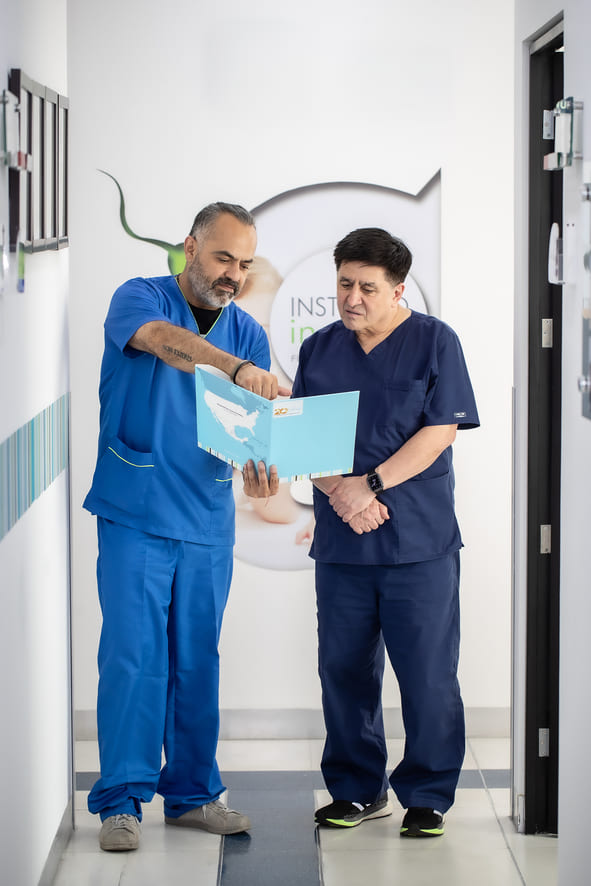
Traditionally, when a woman’s oocytes showed issues in metabolism, structural organization, or cellular division, egg donation was considered the only viable option. IVF MORE® changes this paradigm by offering a patented scientific alternative to restore and optimize a patient’s own oocytes, making pregnancy with her genetic material a real possibility.
Autologous Germline Mitochondria Energy Transfer : https://www.ncbi.nlm.nih.gov/pmc/
articles/
Magnetic Fields – Nature: https://www.nature.com/articles/
Edad avanzada, el óvulo comete errores genéticos: Large cytoplasm predisposes oocytes to meiotic errors: http://www.cdb.riken.jp/en/0629_10912.html
Ovario poliquístico: https://pubmed.ncbi.nlm.nih.gov/17148555/ + https://pubmed.ncbi.nlm.nih.gov/34552933/
Endometriosis: https://www.ncbi.nlm.nih.gov/p6.pdf + https://pubmed.ncbi.nlm.nih.gov/5/ + https://www.ncbi.nlm.nih.gov/.pdf + https://pubmed.ncbi.nlm.nih.gov/31211846/
How Does IVF MORE® Work?
IVF MORE® is an innovative technique that restores low-quality eggs to increase the chances of pregnancy using the patient’s own eggs. Here’s a step-by-step breakdown:
Personalized medical consultation
Everything begins with a consultation to evaluate your case and define the appropriate treatment.
Ovarian stimulation and retrieval
The ovaries are stimulated to obtain eggs. Even with just one mature egg, we can move forward with the process. Once retrieved, the eggs are vitrified along with the semen sample (if applicable).
Metabolic diagnosis of the egg
Once thawed, the egg’s metabolism is analyzed.
Literature:
Envejecimiento y estrés oxidativo: https://pubmed.ncbi.nlm.nih.gov/34121193/ DOI: 10.1002/jcp.30468 Desregulación metabólica en los ovocitos de pacientes con baja reserva ovárica: Zhu, Q., Li, Y., Ma, J., Ma, H., & Liang, X. (2023). Potential factors result in diminished ovarian reserve: a comprehensive review. Journal of Ovarian Research, 16(1). https://doi.org/10.1186/s13048-023-01296-x
IVF MORE® treatment
The egg is restored by infusing it with energetic and mitochondrial factors to correct deficiencies. Cytoplasm from donor eggs may be used if needed, without affecting the genetic material of the patient’s egg.
In vitro fertilization via ICSI
The best sperm cells are selected using advanced techniques, and fertilization is performed through Intracytoplasmic Sperm Injection (ICSI).
Culture in magnetic fields
Embryos are cultured in a magnetic field environment that reduces cellular stress and lowers the risk of chromosomal errors during cell division (embryo development).
Literature:
Magnetic Fields – Nature: https://www.nature.com/articles/srep37407
Embryo transfer
The endometrium is prepared, and one or more restored embryos are transferred. If there is any deficiency in the endometrial lining, regenerative medicine treatments such as endometrial regeneration may be used.

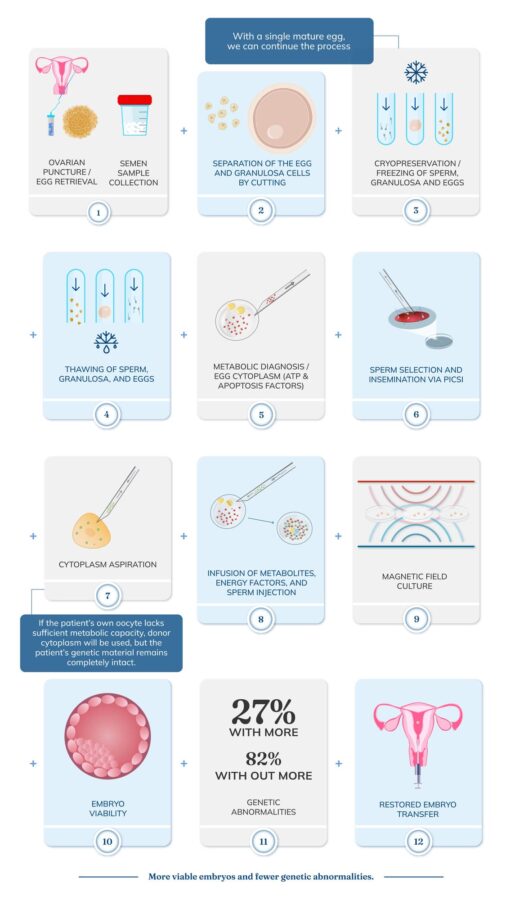
Benefits
Studies conducted with IVF MORE® have shown promising results:
- Significant Increase in Viable Embryos: In women with poor egg quality, the use of IVF MORE® tripled the number of viable embryos compared to untreated eggs. 70% of restored eggs produced viable embryos.
- Reduced Genetic Risk: The rate of embryos with chromosomal abnormalities decreased from 82% to 26%, a percentage comparable to that of young eggs.
- Higher implantation and pregnancy rates: Patients over 40 who were previously unable to produce viable embryos are now able to achieve pregnancy using their own eggs.
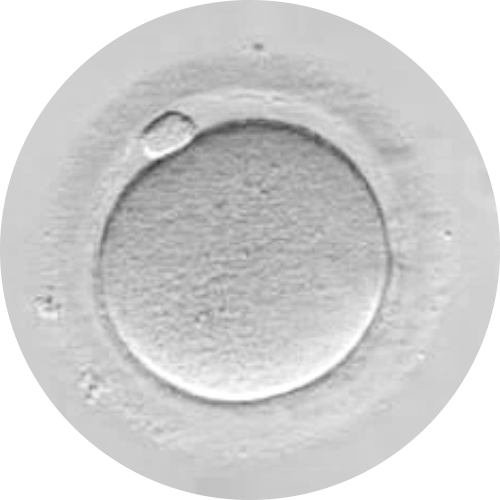
RESTORED EGG
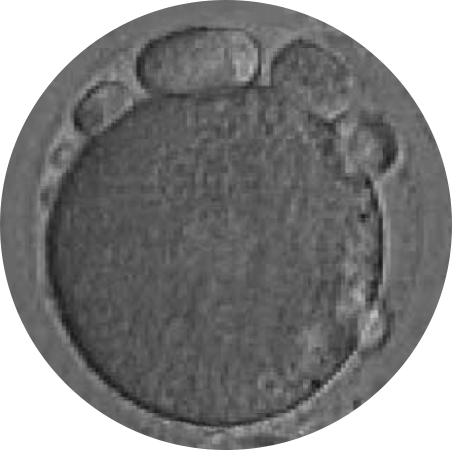
POOR OOCYTE QUALITY
Limitations
IVF MORE® is a revolutionary technique that restores the quality of oocytes, but there are cases in which its application is not possible.
The main limitation for undergoing IVF MORE® is the total absence of oocytes. This technique is designed to improve oocyte quality—without a mature egg to restore, the treatment cannot be performed.
In some cases, even in women who have stopped menstruating, it is still possible to retrieve eggs through controlled ovarian stimulation. If at least one egg can be recovered, IVF MORE® becomes a valid option to improve its quality and increase the chances of achieving pregnancy with the woman’s own eggs.
If no viable eggs are present, egg donation may be considered as an alternative to help the patient become a mother.
The Problem: Egg Quality Deterioration
As age advances, eggs undergo metabolic and structural alterations that affect their ability to generate viable embryos due to advanced age, endometritis, or polycystic ovary syndrome (PCOS).
Decrease in the production of energy molecules (ATP):
Poor oocyte metabolism compromises cell division, a key process in the early stages of embryo development.
Increase in oxidative stress:
The accumulation of reactive oxygen species (ROS) can damage the egg’s DNA and mitochondria, impairing its function.
Cytoskeletal disorganization:
The egg’s internal structures, essential for proper division, become compromised, making normal development difficult.
Genetic alterations:
Errors in cell division increase the risk of chromosomal abnormalities during embryonic growth, reducing the chances of a successful pregnancy.
In addition to age, certain gynecological conditions like endometriosis and polycystic ovary syndrome (PCOS) can also negatively affect egg quality, lowering their potential to create viable embryos.
- Endometriosis:
The chronic inflammation caused by this condition can alter the ovarian environment, generating oxidative stress and damage to the follicular surroundings. This impacts both egg maturation and function, reducing its ability to fertilize and develop into a healthy embryo. - Polycystic Ovary Syndrome (PCOS):
Although women with PCOS typically have good ovarian reserve, hormonal and metabolic imbalances can affect egg quality. Eggs produced in these cases often struggle with proper maturation and may fail to divide correctly after fertilization.
These factors contribute to poor oocyte quality, IVF cycle failures, cycle cancellations, embryo development arrest, and the formation of abnormal embryos (with chromosomal abnormalities), increasing the risk of pregnancy loss and implantation failure.
Edad avanza, el óvulo comete errores genéticos: Large cytoplasm predisposes oocytes to meiotic errors: http://www.cdb.riken.jp/en/news/2017/
researches/0629 _10912.html#:~:text=The%20oocyte%27s% 20large%20cytoplasm%20is,segregation%20errors %20observed%20during%20meiosis
The Solution: Egg Restoration with IVF MORE®
IVF MORE® addresses these issues through a multi-step approach
IVF MORE® Origins
Innovation That Transforms Lives
At IVF MORE®, we combine cutting-edge science with regenerative medicine to offer new possibilities to those seeking to build a family. Our technique was developed in collaboration with Dr. Shoukhrat Mitalipov, pioneer in reproductive biology and college professor in Oregon, using the latest in molecular biology to restore low-quality oocytes. With over 19 babies born thanks to this technology—currently undergoing publication in high-impact scientific journals—we continue to move forward, delivering innovative and accessible solutions in assisted reproduction.
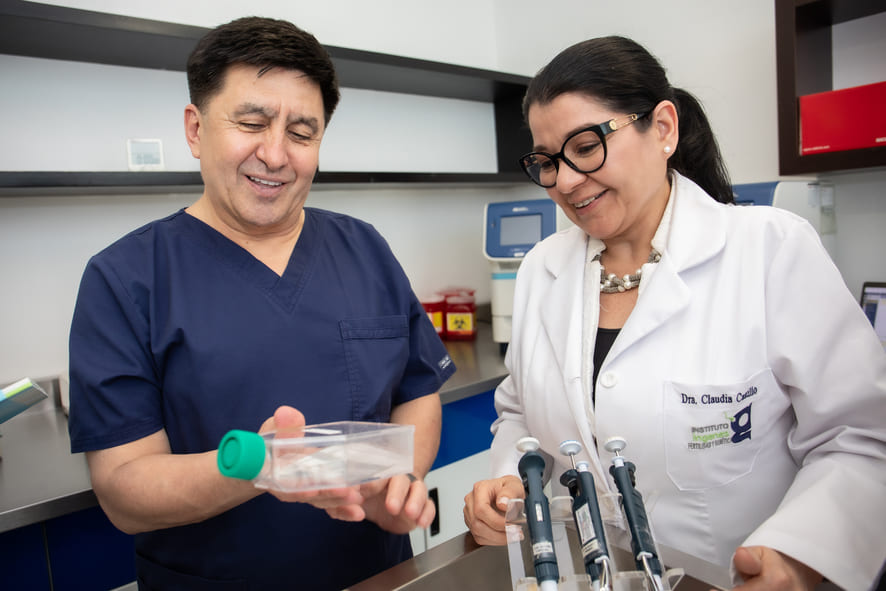
IVF MORE® Origins
IVF MORE® is not just an assisted fertilization procedure—it is the result of years of research in reproductive biotechnology, molecular biology, and advanced micromanipulation. Its development represents an unprecedented breakthrough in oocyte restoration, giving women with poor oocyte quality or diminished ovarian reserve a renewed opportunity to conceive using their own eggs.
Schedule your consultation today
Take the first steps towards your baby with IVF MORE.
Our team is ready to help you every step of the way.
